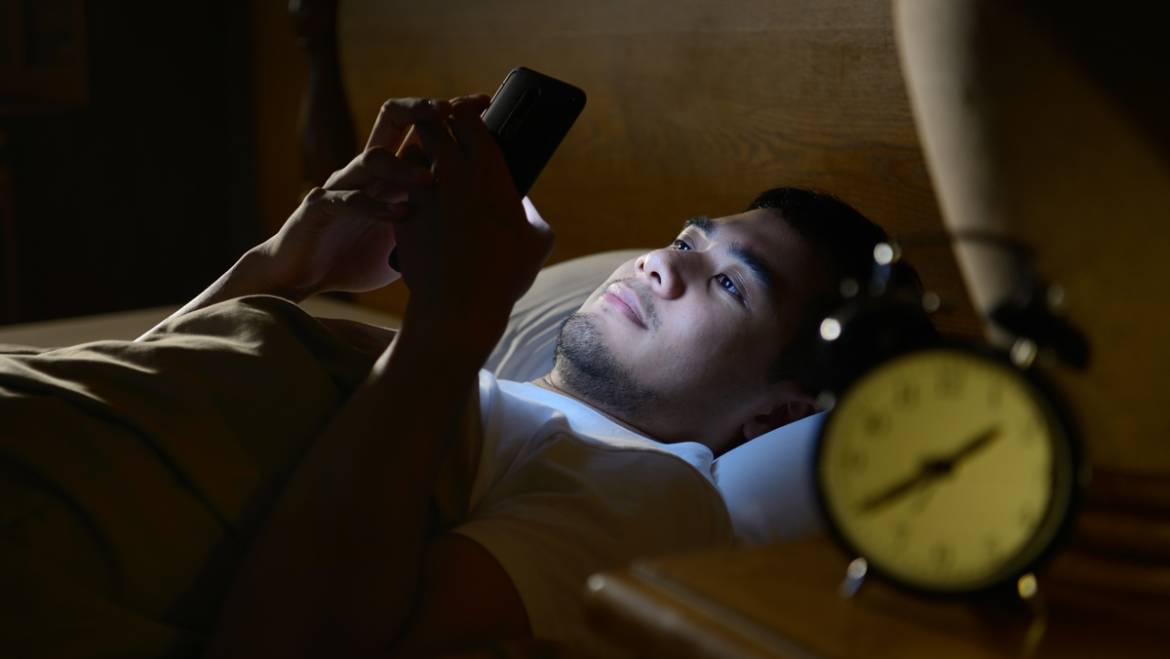Sleep is the altered state of consciousness that occurs when the brain leaves the person in a condition of reduced activity and responsiveness to the environment (Gray, 2002). Humans spend approximately 1/3 of their lives in this state (Gray, 2002; Vgontzas, 1999). Sleep must be differentiated from a state of rest, as mere rest does not create the restorative state of having slept (Dahl, 1996). The essential difference between sleep and a deeply relaxed state is that “sleep involves dropping into a state with a relative loss of awareness of and responsiveness to the outside world,” (Dahl, 1996, p 355). The state of unresponsiveness appears vital for the restorative processes that occur during sleep. Restorative sleep requires the proper continuity, timing, and patterning of different stages of sleep, as well as the timing of sleep in relation to other biological rhythms (Dahl, 1996).
Stages of Sleep
Sleep is an active process that involves dynamically changing brain wave patterns and five progressive sleep stages. The five sleep stages include four stages of non-rapid eye movement (NREM) sleep and a stage of rapid eye movement (REM) sleep.
While awake, the brain produces beta waves, which are low-amplitude, fast, unsynchronized, irregular waves (Gray, 2002). During the transition between wakefulness and sleep, the brain produces mostly high amplitude, low frequency theta waves with brief periods of slow alpha waves (Stage 1 NREM sleep). This stage lasts for only a few minutes and occupies approximately 5% of sleep time in healthy adults (American Psychiatric Association [DSM-IV-TR], 2000). Stage 2 NREM sleep, which occupies about 50% of time spent asleep (American Psychiatric Association [DSM-IV-TR], 2000), consists of larger brain waves and occasional quick bursts of activity known as sleep spindles. During this stage, the sleeper’s body functions slow down, his or her blood pressure, metabolism, hormone secretions, and cardiac activity decreases, and s/he is easily awakened by sounds (Gray, 2002). The sleeper gradually descends deeper into sleep, becoming more and more detached from the outside world and increasingly more difficult to awaken (Stage 3 NREM sleep). This stage occurs approximately 30-45 minutes after the sleep cycle begins and marks the beginning of deep sleep. During this time, 20 to 50% of brain waves are delta waves, and the rest are theta waves. When more than 50% of brain waves become delta waves, the sleeper enters Stage 4 NREM sleep, which denotes the deepest of the sleep stages before REM sleep begins. Stages 3 and 4 NREM sleep occupy approximately 10-20% of sleep time (American Psychiatric Association [DSM-IV-TR], 2000) and are accompanied by decreased muscle tension and slowing of the respiratory and heart rate (Gray, 2002).
After the first phase of deep sleep ends, the sleeper returns to Stage 2 NREM sleep and then enters REM sleep. REM sleep occupies approximately 20-25% of total sleep time (American Psychiatric Association [DSM-IV-TR], 2000), and produces unsynchronized waves that resemble the beta waves of alert wakefulness. REM sleep is sometimes called emergent Stage 1 sleep because it marks the onset of a new sleep cycle, and this stage is signified by frequent bursts of rapid eye movement, muscular paralysis with occasional muscular twitches, rapid and less regular respiratory and heart rate, and penile erection in males (Gray, 2002). Additionally, the most vivid story-like dreaming occurs in this stage. Although each of sleep stage has a number of specific, easily recognizable physiological responses, REM sleep includes a number of seemingly contradictory physiological responses, which is why this stage is known as “dream sleep,” “paradoxical sleep,” and “active sleep.”
The average person has four to five, 80-100 minute sleep cycles every night (Gray, 2002). Healthy adults demonstrate a gradual decent into deeper stages of slow-wave sleep, then follow with a rapid lightening of slow-wave sleep, and then finally enter REM sleep. With each successive cycle, more time is spent in light-slow wave (Stage 2 and Stage 3 sleep) and REM sleep than the deeper stages of slow-wave sleep. The duration of each REM period increases as successive cycles have been completed. Beginning with a period of five to ten minutes, REM cycles eventually reaches a duration of twenty to twenty-five minutes. This may be attributable to the fact the REM sleep has a number of different durations throughout an individual’s nightly slumber.
Improving Your Sleep
Are you one of those people that can’t keep your eyes open during the workday, and yet can’t keep them closed at night because your mind is racing with everything you were supposed to do, need to do, and everything in between? You’re not alone. And just because we live in the city that never sleeps doesn’t mean we need to be one of those people!
Although sleep disturbances sometimes require more comprehensive treatment, here are some Basic Tips:
Make Lifestyle Changes:
- Avoid heavy meals around bedtime
- Have them a minimum of 3 hours before
- Limit caffeine throughout the day
- Caffeine can stay in your system as long as 10 hours
- Expose yourself to natural sunlight during the day to aid your circadian rhythm
- Watch your alcohol intake
- Too much alcohol will initially sedate you; however, when it is metabolized through your system, it can cause arousals that last two-three hours that can disturb your sleep
- Maintain a regular sleep schedule.
- Remember: sleep is regulated by the time you wake up!
- If you are someone who naps, the best time to nap is the halfway point of your sleep cycle, 12 hours later
- Exercise regularly
Set the Conditions for Sleep:
- Remove light, wear an eye mask, use dark curtains
- Hide the clock
- Make a sleep routine
- Avoid using devises with bright screens an hour before bedtime
- Use your bed for sleep or sex only
- Watch TV on the couch
- Make sure your room is cool enough
- Guidelines suggest between 60-67 degrees F
- Use a Pink Noise Machine
- White Noise is good for masking NYC sounds, but I prefer Pink Noise for these reasons:
- Two separate research groups (Zhou et al., 2012 & Ngo et al., 2013) who tested the effect of pink noise on adult participants during nighttime sleep and daytime napping found that individuals who utilized pink noise machines experienced more refreshing, restful stage of sleep, and longer sleep, than adults with no noise. Multiple recent studies (Papalambros et al., 2017 and Ong et al., 2016) also found improved memory and performance with use of pink noise at night.
Advanced Tips to review with your clinician:
- Relaxed Breathing Exercises
- Diaphragmatic Breathing
- Progressive Muscle Relaxation
- Guided Imagery Techniques
- Meditation
- Sleep Diaries
- Cognitive Restructuring to change your thoughts about sleep
- Anxiety Management Techniques to put your mind at ease
Here is a Take Home Technique to Try Tonight:
4-7-8 Breathing Technique: Breathe in for four seconds, hold for seven, breathe out for eight. Repeat four times. *This is hard to do at first, so keep practicing!
This is the first blog of my sleep series. Stay tuned for more…
References
American Psychiatric Association. (2000). Diagnostic and statistical manual of mental disorders (Revised 4th ed.). Washington, DC: Author.
Dahl, R.E. (1996). The regulation of sleep and arousal: development and psychopathology. Development and Psychopathology, 8, 3-27.
Gray, P. (2002). Psychology. Fourth Edition. Worth Publishers, New York.
Ong., J.L., Lo, J.C., Chee, N., Santostasi, G., Paller, K.A., Zee, P.C., Chee, M. (2016). Effects of phase-locked acoustic stimulation during a nap on EEG spectra and declarative memory consolidation. Sleep Medicine, 20, 88–97.
Papalambros, N.A., Santostasi, G., Malkani, R.G., Braun, R., Weintraub, S., Paller, K.A., & Zee, P.C. (2017) Acoustic enhancement of sleep slow oscillations and concomitant memory improvement in older adults. Frontiers in Human Neuroscience, 11(109) 1-14.
V.Ngo, H.V., Martinetz, T., Born J., & Mo, M. (2013). Auditory Closed-Loop Stimulation of the Sleep Slow Oscillation Enhances Memory. Neuron, 78, 545–553.
Vgontzas, A.N., Kales, A. (1999). Sleep and its disorders. Annual Review of Medicine, 50, 387–400.
Zhou, J., Liu, D., Ma, J. Zhang, J., & Fang, J. (2012). Pink noise: effect on complexity synchronization of brain activity and sleep consolidation. Journal of Theoretical Biology, 306, 68-72.




4 Comments
I don’t even know how I ended up here, but I thought this post was great. I do not know who you are but definitely you’re going to a famous blogger if you aren’t already 😉 Cheers!
Thank you so much for reading my blog and for sharing your kind words! I’m glad you enjoyed the content. I will be writing more about sleep– so stay tuned– and let me know if there is a topic you would like me to write about next. Warm regards!
Thank you for reading!
Add Comment